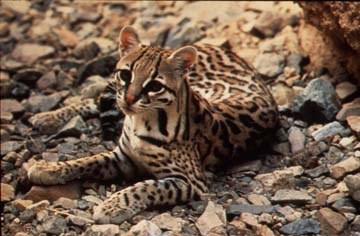The Thicket Game
4th Grade Activity - Teacher Directions

Summary
Students play a hide and seek game as they learn the importance of habitat and animal adaptations.
Background
Animals adapt to their environments in order to survive. In the distant past, most of the South Texas Plains was covered with thick shrubs, grassland, and brushy plants. This provided shelter and protective cover for the animals of the region, particularly the ocelot. Ocelots hunt rabbits, small rodents, and birds. The ocelot has suffered due to loss of its habitat and is on the endangered species list.
Skills
Science: Adaptation, Habitats
Student Preparation
Understand the parts of habitat: food, water, shelter, space (suitable arrangement of habitat elements).
Knows the definition of "endangered"
Materials
Blindfolds
Outdoor area, like a thicket or vegetated area. If not possible use a playground with two students grouped together to represent shrubs or vegetation.
Optional: Make an Ocelot Mask (PDF)
Procedure
- Take students outside for this activity.
- Blindfold one student who will be the "prey" (rabbit, rodent, etc.) with remaining students representing ocelots. Remember some students must represent shrubs and brush.
- The "prey" slowly counts to 20 while the ocelots hide in the brush. The hiding ocelots must be able to see some part of the "prey" at all times.
- After counting the prey removes the blindfold and looks for predators. The prey can turn around; squat, and stand on tiptoe, but not walk or change location.
- The prey should located as many ocelots as possible and call them out by location.
- All of the identified ocelots come out from hiding and join the original prey. They will become prey when the next round starts.
- When ready to begin another round. All prey put on blindfolds. All prey should be in close proximity and have the same restrictions of movement as the original prey.
- While the original prey is counting to 20 again, all the ocelots must move closer to the prey and hide.
- All the prey remove their blindfolds and take turns identifying the "ocelots" they see.
- Play as many rounds as necessary until only one or two students are left hidden.
- Discuss with students what made the ocelots successful in getting close to the prey. Guide students into realizing how important brush cover is for concealment. What would happen if the dense brush land were cleared for farming or cities? Have students explain in their own words how the ocelot is dependent on its habitat for survival.
Extension:
Discuss the current status of the ocelot as a rare species. Some species adapt to changes in their habitat more easily. These "generalist" or opportunistic species can fare well despite changes in habitat. Discuss the advantages and disadvantages of saving habitat for a variety of species, including species that don't easily adapt to change.
The Ocelot and Its Habitat Classroom Activities Includes more detailed version of The Thicket Game, other activities, math problems and word find. Emphasizes the challenges to rare species.